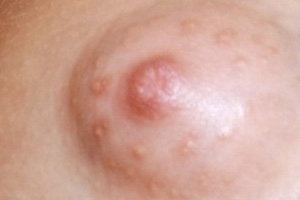

With the onset of pregnancy, a woman is transformed: her forms acquire an appetizing roundness, facial features - a pleasant softness, and mammary glands - fullness. An increase of 1 - 2 sizes is not the only metamorphosis that occurs with the breast at this time. So, pregnancy adorns the areolas of the mammary glands with pronounced Montgomery tubercles. What is it, read the article.
Montgomery's tubercles are specific glands that are located on the pigmented area around the nipple. Some time after conception, they increase significantly in size and remain so until the onset of lactation after the birth of the baby. This structural feature of the mammary gland got its name thanks to the physician William Montgomery - an Irish obstetrician noted the presence of tubercles on the female breast and described this phenomenon in 1837.
The number of Montgomery tubercles on the areola of the breast in each woman is individual, on average from 4 to 28 pieces. They look like miniature nipples surrounding the large nipple along the periphery. The duct of each tubercle contains a substance that balances the pH level on the skin of the areola and protects it from the action of harmful bacteria. Sometimes the glands produce small portions of a substance similar in composition to colostrum. This specific secret keeps the skin in good shape, giving the areola the necessary elasticity. The active state of Montgomery's tubercles is ensured by regular and thorough water procedures for the breast.
In fact, bulging seals are not nipples. These are normal glands in breast tissue. After conception, they swell a little, which gives reason to consider enlarged Montgomery tubercles as a sign of pregnancy. Thus, the female body reacts to pregnancy, which as a result will end in childbirth and lactation.
In the first months of the delicate position, the breast is very sensitive and painfully reacts to the slightest touch. For this reason, some women are forced to pause in their sexual life. True, there are lucky women in whom changes in the mammary glands are not so pronounced. However, in the vast majority of pregnant women, the breast still becomes a very painful point. As the pregnancy progresses, the nipples and areola around them darken. The areoles also increase in size, convex dark nodules appear on them. The appearance of the Montgomery tubercles during pregnancy is approximately the same for everyone - such as in the photo:
With the advent of the second trimester of pregnancy, the breasts begin to increase in size: the mammary glands prepare in advance for milk production and breastfeeding, Montgomery's tubercles are clearly visible on the areolas. Shortly before giving birth, a woman's bust is much larger than its original size - it's time to pick up a special nursing bra and get used to it.
The growth of glandular nodules on the chest as pregnancy progresses is due to several factors:
Here a completely logical question arises: why is this happening, what is the purpose of the Montgomery tubercles? Nature endowed them with an important property to produce an antibacterial substance to lubricate the nipples. This is very important during breastfeeding. The enlargement and darkening of the areolas and nipples during pregnancy is an evolutionary change that helps the newborn find the nipple.

In order to at least slightly alleviate the pain associated with swelling of the mammary glands, the expectant mother can pick up a tight bra that will support her breasts well. Cool compresses are also good for pain relief. To soften dry and extremely sensitive nipples, special creams are used that will make the skin softer.
Montgomery's tubercles are considered one of the earliest signs of pregnancy, but in most non-pregnant women, these glands also show prominently on the chest. For the first time, the appearance of tubercles on the areola of the girl's breast can be noted after the onset of puberty. This means only one thing - the girl is actively forming the menstrual cycle. With the onset of the first menstruation, the appearance of the Montgomery tubercles and the areola as a whole, as a rule, remains unchanged. If there is no pregnancy, the glands are weakly expressed, and their compaction and swelling on the eve and during critical days indicates the characteristics of the hormonal background of the body.

The glands are constantly active: they produce sebum, which brings hair follicles to the surface of the skin. However, the secret of Montgomery's tubercles cannot always leave their ducts, since hair follicles are often blocked by an accumulation of dead epithelial cells or bacterial waste products. When the time is clogged with such a plug, the duct of the gland becomes inflamed and a white head appears at the top of the Montgomery tubercle, in other words, a pimple. It is impossible to squeeze out its contents, otherwise you can injure the delicate skin of the areola of the chest or provoke the penetration of pus and infection further into the duct of the gland. After a while, it's time to get rid of the cork itself, pushing it out or, conversely, absorbing and dissolving it. Sooner or later, the natural cleansing of the clogged gland will occur without your participation.
Medical practice has recorded cases of inflammation of the tubercles on the areola of the chest. From the photo of the inflamed tubercles of Montgomery during pregnancy, we can conclude that the main symptom of this condition is a noticeable reddening of the seals themselves and the skin of the areola around them. In addition, with inflammation, the chest becomes painful. In rare cases, exudate accumulates in the ducts of the Montgomery glands, and secretions appear, which normally should not be.
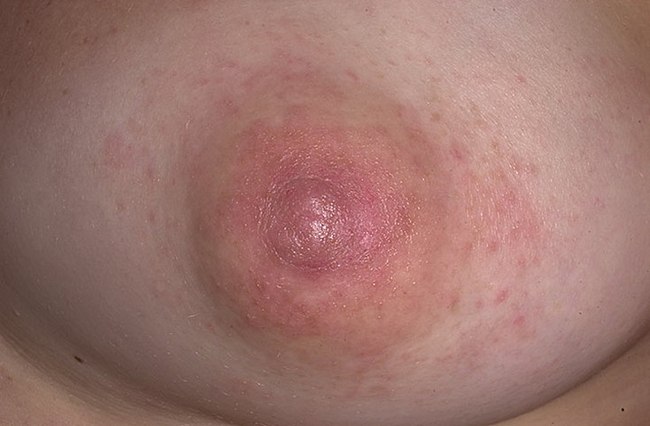
Needless to say, unnatural changes in the appearance of the nipple, areola and the breast itself during the period of expectation of the baby should certainly alert the expectant mother? To clarify the situation, a pregnant woman can sign up for a consultation with a mammologist or gynecologist.
If you are not one of the timid, refrain from the temptation to heal yourself: without knowing it, you can only spur the development of the inflammatory process. Inflammation of the Montgomery glands during pregnancy is an extremely undesirable phenomenon. The body of a woman expecting a child is very weakened during this period, since all its defenses are focused on the successful development of the fetus. At the same time, significant changes occur in the hormonal sphere of the body. The breast reacts to this with increased sensitivity, darkening and enlargement of the areola and nipple. If these metamorphoses are also joined by an excessive increase in the Montgomery tubercles and pain from touching them, then this is the first bell - perhaps the chest requires the attention of a competent specialist.
With inflammation of the Montgomery glands in the expectant mother (this also applies to non-pregnant women), you need to treat the breast with an antiseptic and consult a doctor. It is strictly forbidden to squeeze out the contents of the inflamed glands, cauterize them, warm up the inflamed places!
To eliminate inflammation, pain and itching of the inflamed areola, the doctor will recommend to the patient medicines that have a disinfecting and anti-inflammatory effect. During pregnancy, homeopathic medicines and herbal medicine are of particular relevance.
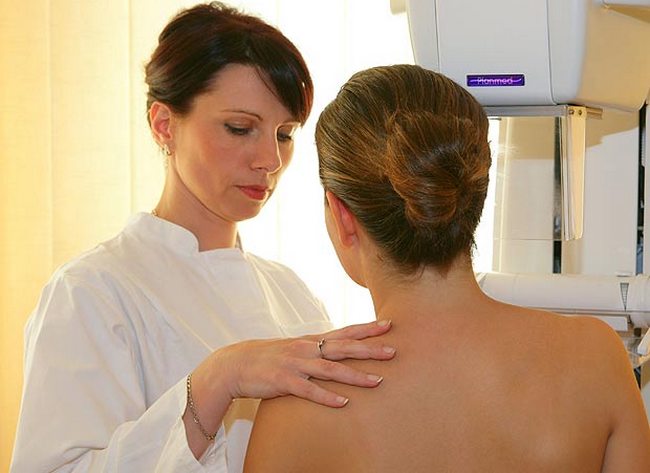
In addition, various physiotherapeutic procedures are used to treat pathology. With an advanced inflammatory process on the chest, the most affected areas can be removed surgically, but the high level of modern medicine has reduced such cases to a minimum.
You can also resort to the services of a surgeon if the enlarged tubercles of Montgomery after the end of lactation have not returned to their original appearance and do not look aesthetically pleasing. After the operation, there will be barely noticeable scars that the naked eye cannot distinguish. Some experts are of the opinion that the functions of the Montgomery tubercles have long been leveled, since these glands are rudimentary. However, most doctors believe that the lubricating antibacterial substance of these seals is of great importance in breastfeeding so it's best not to touch them.
To maintain breast health during pregnancy and lactation, it is important for a woman to know how to properly care for the mammary glands during this crucial period of life.
Choose comfortable underwear. During pregnancy, your bust can become heavier by a whole kilogram, so the usual bra for a certain time will have to be replaced with a special one, with wide straps and pitted. It will ensure the correct position of heavy breasts, and will not compress the milk ducts during lactation.

When milk begins to arrive in the breast, the clothes of a young mother can be soaked through with it. At this time, it is necessary to strictly observe the hygiene of the mammary glands - this is of great importance not only for the newborn, but also for the health of the woman herself. To do this, special pads are put into the cups of the bra, which will protect the mammary glands from possible infection and clothes from wet spots.
During hygienic water procedures, the breasts can be rinsed with water at room temperature and gently massaged in circular motions. It is useful to pour nipples with cool water. During pregnancy, the skin of the mammary glands in most cases becomes excessively dry. To avoid adding fuel to the fire, don't take hot showers and don't use soap. A warm, relaxing shower with a moisturizing gel is most suitable for pregnant women. After a shower, a nourishing cream is applied to the skin of the body, and problem areas (chest, abdomen, buttocks) can be pampered with a special remedy for stretch marks.
To prepare the breast for feeding the baby, there is a special massage. Before performing it, the expectant mother should discuss this issue with her gynecologist, since nipple stimulation is not indicated for all pregnant women. The complex system of nerve impulses of the uterus and breast is closely interconnected, and massage of the nipples can cause uterine contractions. And this, as you understand, with a high risk of miscarriage and a number of other problems, is highly undesirable. The doctor will decide if nipple massage is right for you and explain how to do it.
Do not forget about cosmetics during the "interesting" position. Every woman wants her breasts to remain firm and attractive for as long as possible, but this cannot be achieved without regular additional moisturizing. Necessary care is unthinkable without cosmetic series, released specifically for expectant mothers. Pharmacy shelves are full of a variety of cosmetics, so that every woman chooses what suits her name: Baby Teva, Our Mom, Mustela, Chicco. By the way, with these products you can take care of your breasts after childbirth, during breastfeeding - such cosmetics will always come in handy. Products that care for the nipples and skin of the breast do not cause allergic reactions and are absolutely safe for the child.

Pregnancy does not always bring a woman only positive emotions. While waiting for the baby, the skin of the expectant mother may become covered with unattractive red, bluish or bright pink stripes - stretch marks, better known as stretch marks. The propensity of a pregnant woman to the appearance of this problem is laid down at the genetic level, but the main prerequisite for the appearance of a defect is inelastic and dry skin, in which fibers are very easily torn at the microscopic level, and in their place scars are formed that appear on the surface of the skin in the form of rough stripes. What can you do to keep your skin beautiful? Get a quality cream for stretch marks and eat right. Nuts, seafood, citrus fruits, milk and eggs - products that increase skin elasticity should always be in your diet.
Pregnancy is an exciting journey that ends with the long-awaited meeting with the baby. Sometimes amazing metamorphoses in one's own body (an increase in Montgomery's tubercles on the chest, the appearance of profuse leucorrhoea, toxicosis) confuse the expectant mother and make her feel self-doubt, but this approach cannot be called correct. With all the exciting questions, you should immediately contact the doctor: it is better to ask once than to get lost in conjectures and assumptions.
Small pimples that are located on the areola around the nipple have a name. This is Montgomery's gland. Inflammation of the Montgomery gland in women may be associated with infection or hormonal changes in the female body, improper breast care, tight underwear.
Small bumps near the nipple are considered vestigial glands. They protect the skin of the areola from dryness and partly have bactericidal properties.
During the peak period of hormonal changes in the body of a woman, for example, during puberty, pregnancy, breastfeeding, the glands increase in size. But then they gradually return to their original state.
Studies have shown that during breastfeeding, the Montgomery glands secrete a special secret, the smell of which stimulates the active sucking of breast milk by the baby.
Enlargement of the glands during puberty is a normal condition and indicates the active growth of the breast tissue, the formation of the menstrual cycle. With the onset of menstruation, the appearance of the Montgomery glands and areola remains the same.
Why are the glands inflamed? The glands reproduce the fatty secret, which is excreted with the help of hair follicles. When the follicles are clogged with epithelial cells, the secret does not leave the ducts. The pores are clogged, a fatty plug is formed, the glands become inflamed.
Inflamed glands cause an unpleasant painful sensation and have the following external signs:
The cause of the inflammatory process may be infection or a hormonal surge. Increase and soreness are pathological processes. If inflammation is detected, a doctor's examination is necessary. Self-treatment, heating, squeezing, cauterization can aggravate the situation. Treatment of inflamed areas with antiseptic agents is allowed.
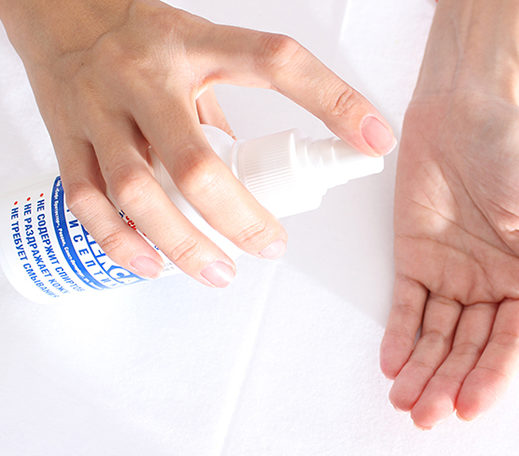
During pregnancy, the immune system weakens, the female body undergoes hormonal changes. Any inflammation associated with mammary glands should be examined by a doctor in order to prescribe adequate therapy.
The main drugs for the treatment of inflamed glands are drugs that disinfect and relieve irritation, itching, redness. Pregnant women are often prescribed homeopathic remedies, herbal medicine.
With severe inflammation, physiotherapy procedures are possible. Very rarely, surgery is used to remove inflamed areas and is mainly aesthetic in nature.
According to statistics, inflammation of the glands of Montgomery is more common in pregnant and lactating women. This is due to the activation of the production of sebaceous secretion by the glands. To avoid inflammation of the areola, it is necessary to follow certain rules of hygiene and breast care.
From the very beginning of pregnancy, the breasts begin to increase. You should choose comfortable special underwear that will provide the desired position for the chest, not squeezing the mammary glands during lactation. When breast milk begins to arrive, you need to use special breast pads to avoid infection and subsequent inflammation of the glands.
The chest should be rinsed with warm water. A light stroking massage around the nipple can improve blood circulation and secretion of the skin. Hot showers are not recommended. The nipple area should not be washed with soap. To cleanse the skin of the areola, any moisturizing body gel is suitable.
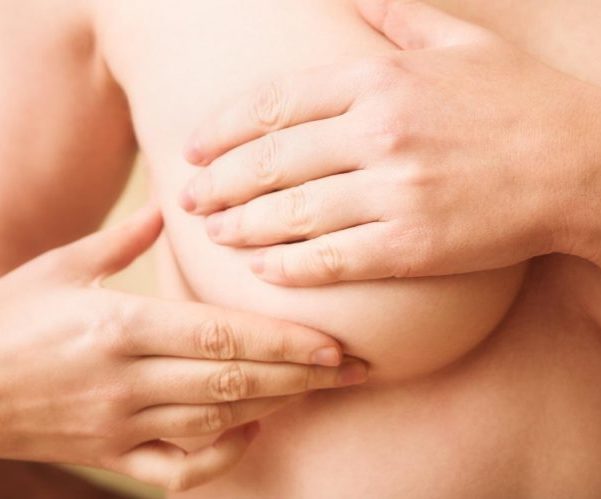
There are many ways to take care of female breast before and after feeding. They effectively care for, moisturize the skin of the breast. In addition, breast care products have anti-allergic properties and cannot harm the baby during feeding.
Another cause of inflammation of the glands of Montgomery can be a passion for topless tanning. The skin around the nipples is very thin and delicate. Active solar radiation dries out the skin, disrupts the secretion of the skin.
Prevention against inflammation proper nutrition which boosts immunity. There are vitamin complexes that have been developed specifically for pregnant and lactating women. They contain all the necessary trace elements and vitamins that improve the immune system.
If, following the rules for caring for the female breast, it was not possible to avoid pathological enlargement and inflammation of the Montgomery glands, then the best solution to the problem would be to consult a doctor and treat.
The functional features of the Montgomery glands are not fully understood. But it is known for certain that they are the protection of the areola and nipple from infections and bacteria. The baby, by the smell that these glands secrete, unmistakably finds the mother's breast. If inflammation of the glands occurs, it is advisable to consult a gynecologist.
Aesthetic problems can be solved in the plastic surgery clinic. Hygienic care of the mammary glands is of great importance. During puberty, pregnancy, breastfeeding, you need to take care of your breasts. It is not advisable to use alkaline soap during water procedures (it dries the skin), underwear should not squeeze the nipple area. With any inflammation, redness, itching and other discomfort in the area of the tubercles on the areola, you should immediately seek the advice of a doctor.
It often happens that the structure of the breast causes surprise in a woman, and in some cases anxiety. Small pimples located on the areola of the nipples are called Montgomery tubercles. They are vestigial glands, today their functions are leveled. At the same time, such neoplasms sometimes significantly affect the appearance of the breast, and often cause concern. You should know what these Montgomery tubercles are, and when you should consult a doctor, in what condition they are.
In medical terminology, tubercles are referred to as Montgomery's glands, you can also find the definition of a gland areola. These anatomical formations are small in size, they are localized along the periphery of the nipple. If we talk about the average number, then usually it is ten or twelve, but sometimes there are only four, or it reaches twenty-eight pieces.
The formations were first described by obstetrician William Montgomery. In our time, they have been fully studied in order to assert their maximum development during gestation and during breastfeeding. At other times they are less noticeable, with rare exceptions.
In medical practice, there are cases when inflammation of the Montgomery tubercles occurs, soreness, redness appear. In exceptional cases, exudate and other unnatural secretions are collected. If pathological changes are found in the halo, a woman should visit a doctor, you can make an appointment with a gynecologist or mammologist.
 In no case should you try to eliminate such an inflammatory process on your own. If inflammation of the tubercles of Montgomery occurs during pregnancy, it affects health especially adversely. It is known that in the prenatal period, the female body is especially susceptible to infections, since the immune system is under significant stress, it is weakened.
In no case should you try to eliminate such an inflammatory process on your own. If inflammation of the tubercles of Montgomery occurs during pregnancy, it affects health especially adversely. It is known that in the prenatal period, the female body is especially susceptible to infections, since the immune system is under significant stress, it is weakened.
In addition, at this time, the hormonal background is being rebuilt, some transformations occur in the chest. In particular, sensitivity is enhanced, the nipple halo is modified. Such sensations cannot be ignored, a woman should notice them in a timely manner. Painful touches to the tubercles, redness in the area of the mammary glands and in the periphery, a strong increase in the Montgomery glands are considered unfavorable signs.
As a rule, women are not sure that they can distinguish a normal condition from a pathology. It should be noted that in the presence of any anxious sensation, consultation with a specialist is necessary. Both during pregnancy and in case of inflammation of the tubercles in non-pregnant women, it is forbidden to extrude, warm, cauterize, and other independent actions to get rid of the pathology. You can only treat the tubercles with an antiseptic and then go to the clinic.
In some cases, Montgomery's tubercles are clearly manifested in girls during adolescence, during puberty. In such a situation, from four tubercles to twenty-eight can be found on the halo. This means that there is an active formation of the female monthly cycle.
When menstruation comes, there should be no change in the halo, its appearance is common, changes are peculiar only to pregnancy. In a non-pregnant woman, in a normal state, the Montgomery tubercles are barely noticeable before menstruation, and if they increase before the next menstruation, this is often due to the peculiarity of the hormonal development of the body. Nevertheless, it is still better to tell the doctor about this, get his advice.
 Montgomery tubercles, the causes of their occurrence in general, cannot be considered a pathology, they are programmed by nature to perform a number of functions. Why are Montgomery tubercles required, what is their purpose? In a woman during puberty, a number of actions are assigned to them, while visibility is always different.
Montgomery tubercles, the causes of their occurrence in general, cannot be considered a pathology, they are programmed by nature to perform a number of functions. Why are Montgomery tubercles required, what is their purpose? In a woman during puberty, a number of actions are assigned to them, while visibility is always different.
At this evolutionary level, this gland is poorly developed, but it still works. The tubercles secrete a natural lubricant that does not allow the nipple to dry out. They also produce a secret with bactericidal properties, and this is especially important during breastfeeding. In addition, the glands produce a smell that attracts the baby to the breast. Colostrum or milk rarely appears in the tubercles.
Often, the tubercles become much more noticeable during gestation, and in this case, this condition is absolutely normal. Therefore, there is no need to take special action. For example, some women note that the increase occurred at the beginning of pregnancy, while others note that a similar factor is observed only with the start of breastfeeding.
 At the same time, the normal state is noted for everyone when the lactation period. In that case, attention is paid to the glands not only because of the size, but also because of inflammation, pain, itching, then the treatment of Montgomery tubercles is carried out by a qualified doctor.
At the same time, the normal state is noted for everyone when the lactation period. In that case, attention is paid to the glands not only because of the size, but also because of inflammation, pain, itching, then the treatment of Montgomery tubercles is carried out by a qualified doctor.
As a rule, the patient is prescribed anti-inflammatory and bactericidal drugs, as well as homeopathic methods, herbal medicine. If the inflammatory process has developed during pregnancy, homeopathy is especially relevant, the emphasis is on such treatment. Inflammation of the Montgomery glands is successfully treated with the use of various physiotherapeutic procedures.
In severe cases, modern medicine offers patients surgical removal of inflamed tubercles. The indications for such treatment are aesthetically unsightly bumps that did not disappear after lactation, or they were formed during puberty and did not decrease in the future. In this situation, the service of a plastic surgeon will be required, after such an operation, microscopic scars remain, almost invisible to the eye.
However, although the glands are considered vestigial, they are important when breastfeeding, it is better not to remove them.
2015, . All rights reserved.
One of the first signs of pregnancy is an increase in the so-called Montgomery tubercles located around the nipple.
These tubercles got their name from the doctor who first began to study them, William Montgomery.
Many experts believe that Montgomery's tubercles are vestigial glands. They were led to this conclusion by the fact that these formations begin to appear during puberty, and their growth is activated during pregnancy, when the woman's body is preparing for lactation.
But the true purpose of Montgomery's glands has not been established.
Some experts defend the point of view that these are sebaceous glands, others - that they are mammary. But both categories of specialists agree that these glands are rudimentary.
It is believed that time breastfeeding Montgomery's tubercles produce a secret that protects the mammary glands from drying out. There is also an opinion that they are able to release a bactericidal substance.
In addition, it has been proven that the greater the number of Montgomery tubercles in a nursing woman, the more actively the baby eats. 
Very often, a woman first pays attention to the formations around the nipple during pregnancy, since before these tubercles did not change in any way. But do not worry about increasing their size, after the end of the period of breastfeeding, Montgomery tubercles usually return to their original state.
If something went wrong, and the bumps did not decrease or became inflamed, consult your doctor. He may prescribe anti-inflammatory or bactericidal medicines for local treatment.
In extreme cases, modern medicine offers plastic surgery services. And although such operations are possible, it is still worth thinking about their necessity.